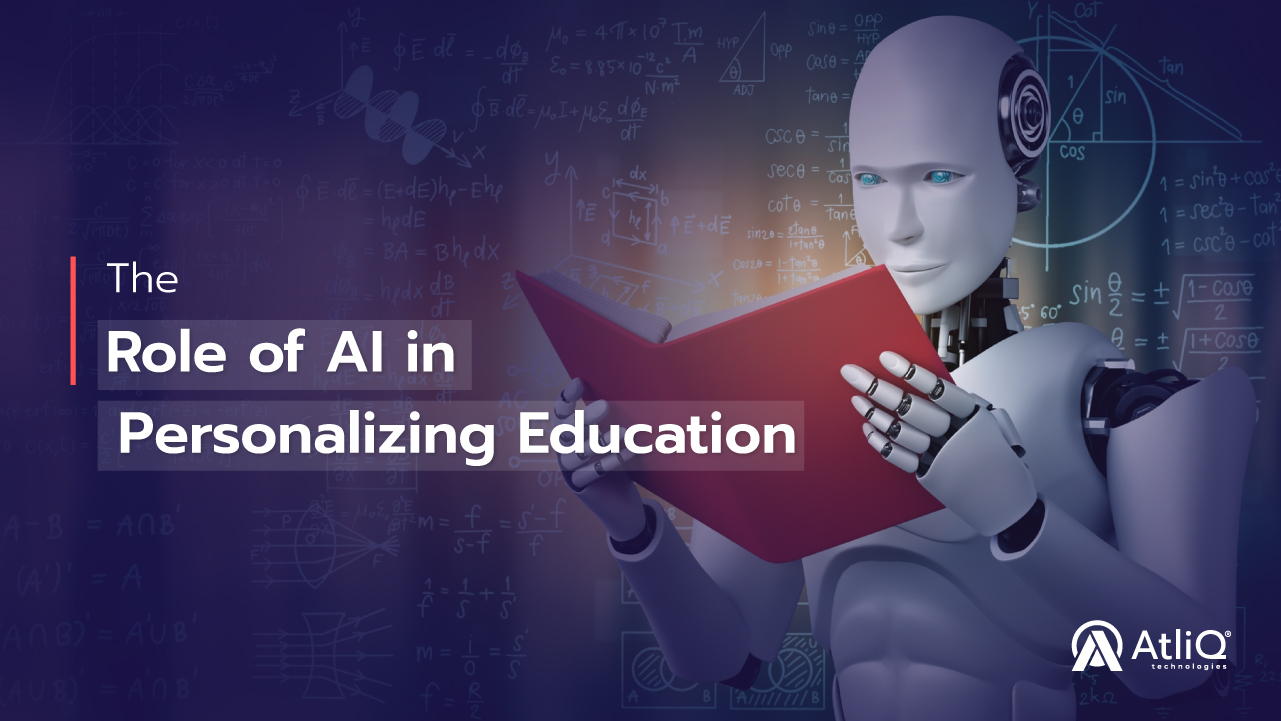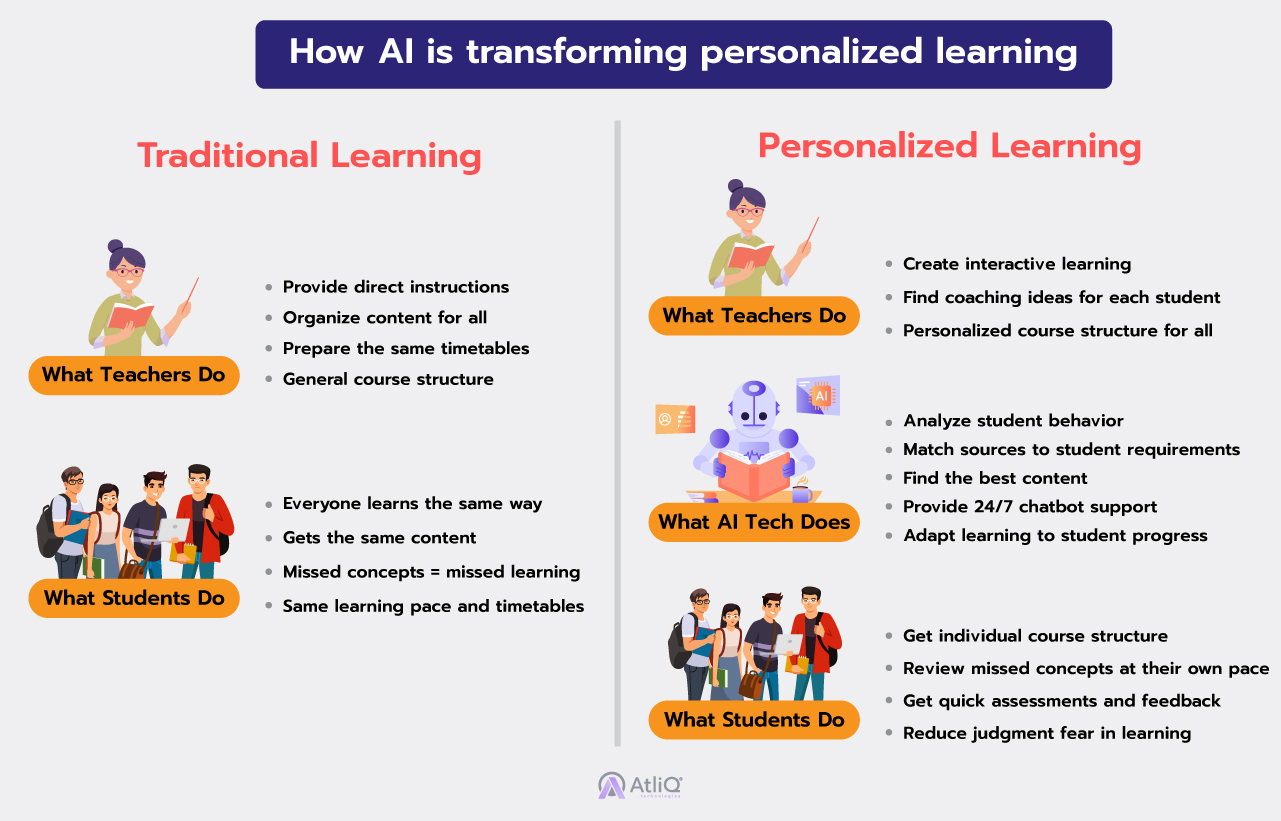
According to AI education statistics 2023, over 49% of learning management systems will use AI as their driving force in the coming three years. Personalized learning, powered by AI, has transformed education.
AI is rapidly changing academic learning. Traditional teaching methods are being replaced by personalized learning experiences, which has its own set of benefits and challenges.
Traditional Learning Vs. Personalized Learning
It’s widely believed that in traditional teaching, students learn the same way.On contrary, AI makes learning more personal by adapting to each student’s needs, strengths, and pace. Here are the few benefits of personalized learning:
- Interactive Learning Platforms—Like GPS
Imagine a platform that adjusts homework or quizzes based on how well a student is doing. If a student performs great through one topic, it moves to the next level; if they struggle, it slows down to provide extra help. AI-powered learning platforms like these analyze each student’s progress—just like GPS, it reroutes according to each student’s pace for learning.
- A Personal Tutor Approach
AI helps teachers give each student materials that match their needs. For example, if a student is strong in math but needs help in reading, AI can recommend challenging math exercises and simpler reading passages. This way, each student gets resources that help them improve in their own way, rather than a general approach
- Quick Assessment and Feedback
AI also speeds up grading and feedback analyzing student behavior. Instead of waiting days for feedback on a quiz, students can get instant responses. For example, if a student struggles with a science concept on a test, the system could immediately provide extra practice in that area. This helps students learn from their mistakes right away.
- Predictive Analytics for Early Help
AI can notice when a student is starting to struggle by spotting patterns in their work. Like, if a student keeps missing questions on a certain topic, AI can notify the teacher, who can then step in with extra help before things get more complicated. This way, every student has a better chance to succeed.
- AI-enhanced chatbots for support and advice
AI chatbots offer students personalized support and advice, with about 91% accuracy. Suppose, if a student is having trouble with algebra, they can ask the chatbot for help and get step-by-step guidance right away. It’s like having a tutor on hand 24/7, helping students stay on track without having to wait for a teacher.
Real-World AI Application
- Stanford University
Stanford uses OpenAI’s models to develop interactive learning assistants for students, providing real-time support on course materials.
Benefits over Traditional Learning:
-
- Faster Support: Students get immediate answers and help, unlike traditional setups where they may have to wait for office hours.
- Self-Paced Learning: AI tools allow students to learn at their own pace, something that’s tough to do in a traditional classroom where everyone follows the same schedule.
- Encourages Exploration: AI chatbots give students the freedom to ask questions anytime, creating a safe space to explore new ideas and learn without feeling judged by others.
- Massachusetts Institute of Technology (MIT)
MIT uses AI to recommend courses and create learning experiences adapting to each student’s needs and interests.
Benefits over Traditional Learning:
-
- Personalized Curriculum: Instead of following the same rigid path, AI recommends courses based on what each student is good at and interested in.
- Efficient Resource Allocation: AI helps teachers spot students who might need extra help, so they can provide the right support where it’s needed most.
- Enhanced Feedback: Instant and detailed feedback on assignments gives students the chance to improve continuously, unlike traditional grading that may come after the learning window has passed.
- Harvard University
Harvard uses OpenAI’s tools to create AI-powered tutoring systems for subjects like math and writing.
Benefits over Traditional Learning:
-
- 24/7 Tutoring: Students can get help anytime, breaking away from the limits of traditional tutoring hours.
- Personalized Practice: AI tailors practice problems based on individual performance, providing a unique experience for each student.
- Reduced Instructor Load: With AI handling basic tutoring tasks, instructors can focus more on complex teaching and mentorship.
Challenges and Considerations
Like any new technology, AI has the potential to bring big improvements, but it also comes with its own set of challenges.
- The Risks of AI Using Student Data
AI systems need a lot of student data to create personalized learning, but privacy risks are a big concern. For schools and governments to prevent student data breaches from edtech platforms, strict privacy laws must be enforced, so that sensitive student data is secured and used with integrity.
- Balance of Tech With Human Connection
As AI takes on more roles in education, lessening human interactions.In South Korea, some schools have introduced AI-powered robots as language tutors, sparking debates on the future role of human teachers. While AI can help personalize learning, it’s the empathy and real-world insight of teachers that make education meaningful.
- Digital Overload: Too Much Screen Time
As more schools use AI apps and online platforms, students are spending more time in front of screens than ever before. A new AI-based homework system in the UK requires students to log on every day, which leads to more screen time and eyestrain. Finding a balance between digital learning and offline activities is important to protect students’ health and well-being.
Conclusion: Artificial intelligence has the potential to make learning more like a personal tutoring experience, providing students with all the resources they need. But it also raises challenges like privacy risks and potential bias. To get the best of both worlds, we need to use AI thoughtfully, blending its benefits with the human touch that makes learning meaningful.
